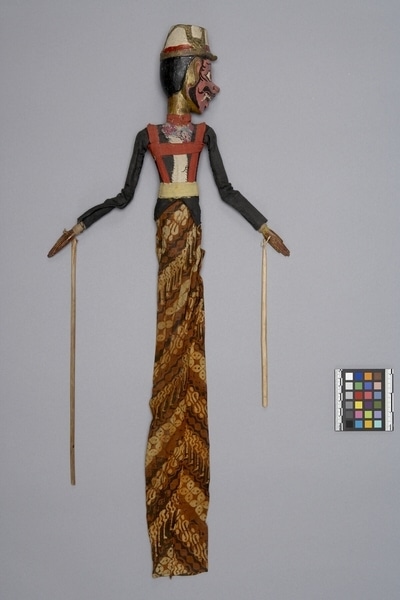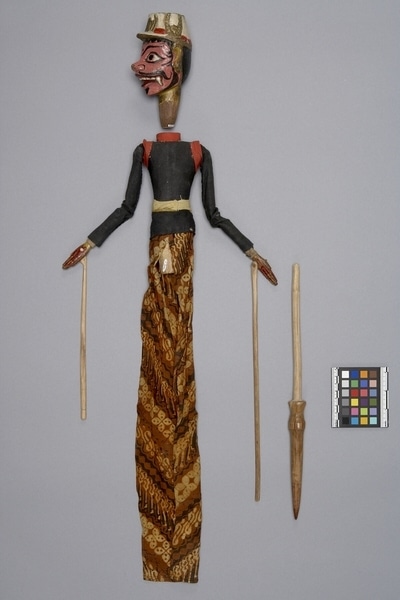Rod Puppet Item Number: Ib327 from the MOA: University of British Columbia


Description
Three-dimensional male humanoid puppet: large head (part b) fits into body with skirt (part a), and a control rod (part c) with a long shaft passes through the body and fits into the neck of the figure's head. The body has jointed arms, each with a long controlling rod attached. Face dark pink, with gold ears and neck. Hair, sideburns, beard, moustache, and eyebrows black. Red irises. White upper teeth and fangs. Prominent upper lip and nose. Wearing white hat, gold and red trim, peaked brim. Cylindrical body shape ending below waist. Wearing cotton long-sleeved black tunic, red collar and suspenders, yellow belt, flowered yoke inset with off-white strip down front. Cotton one-piece skirt open in back, patterned brown, yellow, and black. Arms in two pieces jointed at elbow. Hands open. Holes in palms through which string passes attaching sticks.
History Of Use
Javanese puppetry as an art form probably developed by the 11th century. The three-dimensional wooden wayang golek puppets of western Java appeared during the 16th century. Originally the plays depicted Javanese mythology, but after the Indian conquest of Java the Hindu epics, Ramayana and Mahabharata, were incorporated into the cycles, which comprise about 200 plays. An individual or group hires a dalang (puppet-master) to celebrate important occasions. The performances often last all night and are generally presented in three acts, with vocal and instrumental accompaniment. The individual plays vary widely in detail but usually involve conflict between good and evil. They serve a moral and religious purpose, and more recently, one of political commentary. Each puppet's character is represented by its appearance and placement onstage; protagonists with strong elements of good are placed to the right, antagonists of violent or evil nature to the left. Sangkuni is found in the Mahabharata cycle. He would be found in plays based on this epic, to the left of the stage. He is known as intelligent but unreliable; he often does not tell the truth, which causes problems for both the protagonists and antagonists.
Iconographic Meaning
Red face, irises, and coarse facial features and hair are typically considered evil traits. They indicate aggressive and untrustworthy nature. Fangs are usually found on ogres and demons. Puppet has many characteristics of Sangkuni, or Gandara, particularly the fangs, hair in bun, attitude of hands, and military jacket.
Cultural Context
Theatrical performance.
Item History
- Made in Java, Indonesia
- Owned by Tradewind Antiques before March 15, 1983
- Received from Museum of Anthropology Shop Volunteers (Funding source) and Tradewind Antiques (Seller) on March 15, 1983
What
Who
- Culture
- Sundanese
- Previous Owner
- Tradewind Antiques
- Received from
- Museum of Anthropology Shop Volunteers (Funding source) and Tradewind Antiques (Seller)
Where
- Holding Institution
- MOA: University of British Columbia
- Made in
- Java, Indonesia
When
- Ownership Date
- before March 15, 1983
- Acquisition Date
- on March 15, 1983
Other
- Condition
- fair
- Accession Number
- 0886/0061